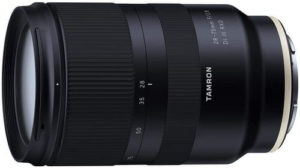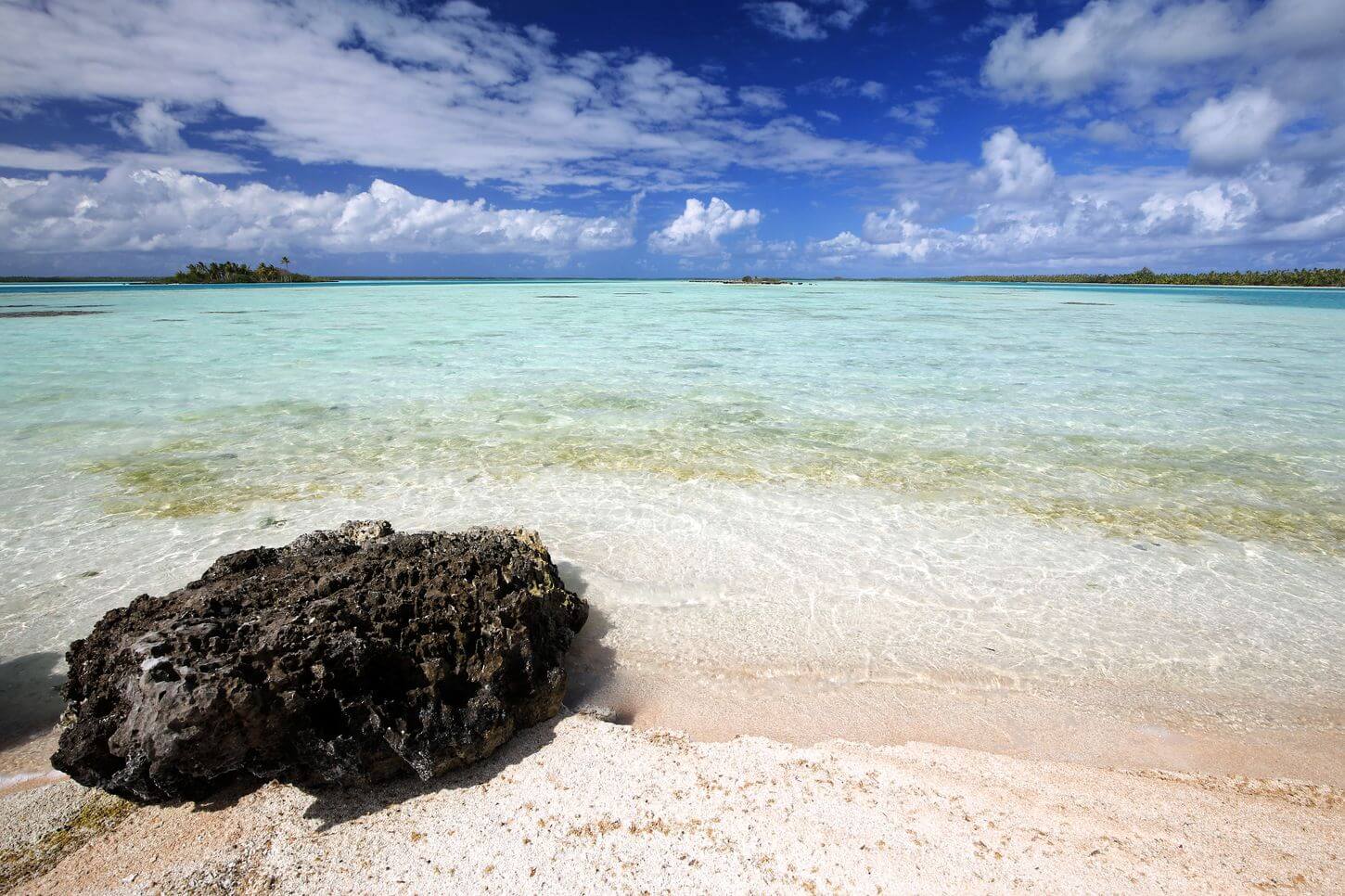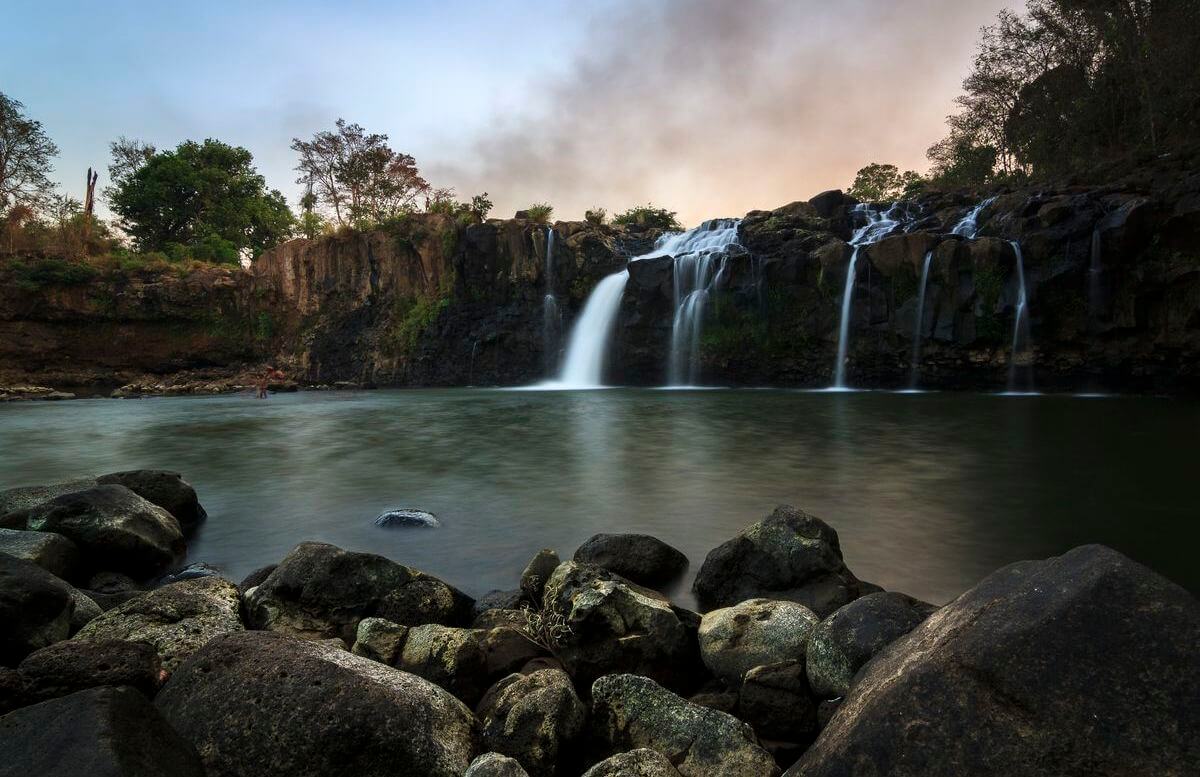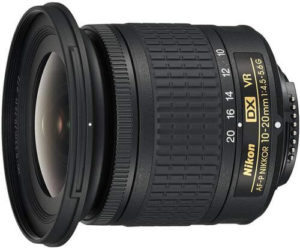What's the best lens for landscape photography?
Last update: 04/19/2024
Our blog continues to grow thanks to you, our readers. This post may contain affiliate links, which means we can earn a small commission if you make a purchase through them, at no extra cost to you. This helps us to continue to bring you more and support our work!
In this photography/travel blog, I’ve been writing more and more recently about camera equipment in general, from choosing the best DSLR to choosing a mirrorless camera or a wide-angle lens. However, there was still one topic that I hadn’t covered much on the blog, at least from a material point of view. This topic is lenses for landscape photography. Indeed, landscape photography is one of the domains that I practice the most and the one where I am the most comfortable.
This specific article will help you to choose your lens for landscape photography. You’re going to tell me, you can do landscape photography with any lens, even with a 18-55mm kit lens. Of course, this is not wrong. But the purpose here is to suggest the possibilities that are available if you want to upgrade to better equipment than the one you got in a kit when you bought your camera.
Voluntarily, I decided to talk about landscape lenses for both DSLR and mirrorless cameras. This article is also a kind of summary of several articles written on the blog (how to choose your wide-angle lens and which lenses to choose for mirrorless cameras) to which I will add a more detailed analysis for landscape photography.
After a quick presentation of the most common lenses used for landscape photography, I will briefly remind you of the technical elements to consider when choosing your lens. Finally, I will give you my recommendations of lenses, sorted by budget, camera types (DSLR and mirrorless), brands and lens types. Let’s get started!
1. The most common types of lenses for landscape photography
As I said in the introduction, of course you can shoot landscape with a wide angle, a macro lens, standard or telephoto lens. No matter what focal length you use, this type of photography is always possible in theory. However, I would limit myself to 3 types of lenses for landscape photography.
Generally speaking, everyone agrees that landscape photography very often rhymes with wide angle and ultra-wide-angle lenses. A lot of pictures you will see are taken with this type of lens that allows a wide angle of view during the shooting and gives an effect of immensity to the scene. Looking for a complete guide on wide-angle lenses?
To a certain extent, you’ll see other photographers taking pictures with trans-standard lenses (medium focal length), often with zooms that allow a certain flexibility in framing without having to move around too much…

A beautiful and bright trans-standard lens, the Tamron 28-75mm f/2.8 (for Sony mirrorless camera) – More details on Amazon

You can also shoot landscape photography with a telephoto lens, here the Sony 70-200mm f/2.8 – More details on Amazon
Finally, telephoto lenses are also among the types of lenses used in landscape photography. I often use them anyway. They are sometimes used when the scenery is “too wide” and you want to isolate a precise detail from it. I also often use it to isolate a distant subject and when the foreground is not that interesting (the latter being obviously visible with a wide angle lens). People also say that the telephoto lens “compresses perspectives”. Although purists will find the term incorrect, using a telephoto lens in landscape photography can give the impression of closeness between foreground and background elements, as if they were very close together, when they may be several kilometers apart. Furthermore, a telephoto lens also makes it easier to reduce the depth of field, allowing a foreground or background to be blurred more easily. Well handled, this gives very aesthetic effects.
2. Choosing your lens for landscape photography
When it comes to camera equipment, of course, there are always different criteria to take into account. I won’t repeat everything I wrote in my article on how to choose a camera lens, but here are in my opinion the essential points to remember before making your choice. You thought it was easy to find a lens!?
a. The focal length
This was discussed in the previous paragraph, and it is the most decisive factor. You will have to choose between a very wide field of view (wide angle), medium (transtandard) or narrow (telephoto). You will probably not be only using your lens for landscape photography anyway.
The focal range of a wide-angle lens will also be adapted for street photography, architectural photography, market shots, etc. Trans-standard lenses can be used in a multitude of situations, except for wildlife and sports, for instance. Telephoto lenses are perfect for distant subjects (wildlife and sports photography). You rarely buy a 300mm lens for landscape photography but for another specific need.
Of course, you will have to pay special attention to the focal length depending on the type of sensor you have (known as crop factor). A 24-70mm lens on a full frame sensor will correspond to a standard lens while you will have to choose a 12-35mm lens on a Micro 4/3 mirrorless sensor (multiplying coefficient x2). A bit of math for fun: 12-35mm x 2 = 24-70mm.
On this article, i won’t talk about Fisheye lenses as these are special lenses with lot of distortion and not optimized for this type of photography.

b. Maximum aperture
It is difficult to take a position on this subject regarding landscape photography. Under normal conditions, with daylight, you won’t need to choose a large aperture for your lens since you will often shoot between f/8 and f/16 and rarely wide open for a landscape.
However, in low light, having a large aperture may allow you to reduce the exposure time of your picture. Although in theory, during those moments, any good landscape photographer will use a tripod to use the optimal settings (ISO at the lowest and large depth of field with f/8 – f/16).
But, as mentioned earlier about focal length, there is a good chance that you will buy a lens that you will use for other specific situations. If you use your wide-angle lens for night photography, northern lights or concert photography, having a wide aperture will definitely be a must. The same goes for a telephoto lens where you often want to isolate the subject from the background (creating a nice bokeh/background blur) and have enough shutter speed to avoid blur. Owning a wide aperture will also help you in both cases. So, in general, I would say that if you can afford it, choose a lens with a large aperture rather than a medium one. If for some special shots, you want to get a shallow depth of field, you will be able to get it then !
c. Stabilization
Another interesting point to take into account is the image stabilization of your lens. It will be less important in general for short focal lengths (you will need less shutter speed to limit blurring). On the other hand, as soon as the light decreases and/or you use long focal lengths, having a stabilized lens can save you a lot of problems or allow you to get certain effects that are difficult to obtain without a tripod (1/2 or even 1s handheld exposure to do some long exposure or blur the passers-by in a street, for example).
d. Your camera body
A few quick words on the body of your camera. Remember that some lenses (for DSLR or mirrorless cameras) are only compatible with a certain type of sensor. For example, there are Canon APS-C wide-angle lenses for APS-C sensors that you can’t mount on a Full Frame sensor. So be careful when making your choice.
e. Fixed (prime) or zoom lenses
This is very often a big debate where nobody really agrees. For a landscape photography lens, I would say it’s a matter of choice, again. Primes lenses will generally be brighter (for the same price), more economical, but requires moving around to get the desired framing. A zoom lens, on the other hand, is more versatile and gives you more framing possibilities without moving. It’s a matter of taste. Here is my complete article on the choice of a fixed focal length or a zoom.
f. Construction and physical data
Of course, there are other important aspects to look at, such as the weight and dimensions of your lens. Each brand also offers different models of cameras with varying quality, from entry-level to high-end. Undoubtedly, constructions will be better in high-end lenses. For telephoto lenses, pay attention to the weight, which can be really important when you choose for a stabilized telephoto and/or with a large aperture.

The Canon RF 15-35mm f/2.8, a bright wide-angle lens for Canon Full Frame mirrorless camera – More details on Amazon

An entry-level wide-angle lens with a “more plastic” quality, the Canon 10-18mm – More details on Amazon
g. Shooting condition
Indeed, depending on the conditions in which you are going to most often capture your subjects (night, day, sunset, etc.), it may be useful to focus on specific lenses. Generally speaking, I would say “who can do more can do less”. I’m not telling you to buy a f/2.8 stabilized lens if you don’t need it for your practice, but if the difference in price and physical characteristics, such as weight, are manageable on your side and you are hesitating between two models, I would advise you to take the one that will offer you the most possibilities in the most situations.
h. The price
Even if it is not strictly speaking a technical point, for many of you it remains the decisive element. This is why I have decided to start my classification while keeping budget in mind…
i. The possibilities with filters
Although some will say that this is just a detail, not all lenses are equal on this point. Very often, landscape photographers use filters to capture the scenes in front of them. Personally, I had a hard time choosing my last wide-angle lens because I didn’t want to change my entire filter system. I’m telling you this because some lenses have a curved/bulbous front lens, which makes it impossible to use a classic screw filter system (of course) but also the classic filter 100mm filter holder system. It will then be necessary to switch to even a more expensive system… So be careful!
3. Which lens for landscape photography, then?
Here is a summary of the lenses I recommend for landscape photography, classified by budget, type of sensor and brand. As mentioned in the introduction, the vast majority of people will use wide-angle and ultra-wide-angle lenses for landscape photography, to a lesser extent transtandard and telephoto lenses. So, I will voluntarily not detail all the possibilities for transtandard and telephoto lenses for landscape photography. There are too many of them and in most cases, you will use this lens for other types of subjects. At the end of the article, I give you some recommendations for standard lenses and some thoughts for telephoto lenses. It is up to you to judge if our interested in sticking to a native brand (Canon/Nikon) or to choose a third-party brand. More and more third-party brands are offering very good value for money lenses, especially Sigma and Tamron. You can have a more detailed look at the Dxo website which tests and reviews all the lenses. For Canon users, I advise you to check out the complete guide I wrote on the best Canon wide-angle lenses!
For each category, I provide a summary table of the different lenses mentioned in this text, allowing you to compare and sort according to your desires/needs.

a. Wide-angle lenses for landscape photography at less than 500$
For information, all the lenses under $500 mentioned in the paragraphs that follow are summarized in the table below. This will help you to compare the main features of the lenses.
a.1. For APS-C DSLR cameras
- At Canon: for a “low cost” wide-angle choice, I particularly recommend the EF-S 10-22 mm f/3.5-4.5 USM and the EF-S 10-18 mm F/4.5-5.6 IS STM.
- At Nikon: Nikon’s AF-P DX Nikkor 10-20mm f/4.5-5.6G VR is still a reference in this price range.
- Among the third party brands, I recommend that you take a special look at three alternative models that exist in the mounts of both Nikon/Canon brands, the Sigma 10-20mm F3.5 EX DC HSM, the Tokina 11-16mm f/2.8, my first high quality APS-C wide angle lens with a nice aperture at f/2.8 and the Tamron 10-24mm f/3.5-4.5Di VC (in my opinion, the best lens for landscape photography for an APS-C sensor)
a.2. For Full Frame DSLR cameras
If you own a full frame body (24×36), the choice of a wide-angle lens at this price is more than restricted since to my knowledge, only Tokina offers a lens: 17-35mm f/4 (there is indeed the 16-28mm f/2.8 but it is slightly more expensive, I talk about it below). Both lenses have a very good reputation and for the price, I think they are two good choices. Among native brands, the budget for a wide-angle lens jumps immediately over 500$ unless you look at the second hand market. At the limit of the 500$ (but often above it), there is the Tamron 17-35mm f/2.8-4 which I’ll talk about later.
I almost forgot, for people with a smaller budget and who are not afraid of manual lenses, Samyang/Rokinon offers an excellent and very well-known 14mm f/2.8 MF (Canon / Nikon). The lens is under 350$ new and it’s clearly a way to start landscape photography without breaking the bank.
a.3. For mirrorless mFT cameras
For owners of a Panasonic/Olympus mirrorless camera looking for a wide-angle lens, in this price range you have little choice. Only the Olympus 9-18mm f/4-5.6 is available with a relatively small and slippery aperture. There is nothing better at that price with an autofocus. For those with a small budget and for whom manual focusing does not bother, Samyang/Rokinon offers very good value for money: a 10mm and a 12mm that opens at f/2.8.

An example of a well known manual focus wide-angle lens for mirrorless camera (mFT), the Samyang 12mm f/2 – More details on Amazon
a.4. For APS-C mirrorless camera
The only wide-angle for APS-C mirrorless camera to my knowledge is the Canon EF-M 11-22mm f/4-5.6 IS STM. There is no lens in this price range available from Fuji and Sony, except the Samyang with manual focus 10mm f/2.8 (Fuji / Sony) and 12mm f/2 (Fuji / Sony).
a.5. For full-frame mirrorless cameras
In this price range, currently, the only wide-angle lenses for full-frame mirrorless cameras would be the Samyang 14mm f/2.8 AF and MF, and the 12mm f/2 (MF) for Sony FE cameras, all with manual focus. Additionally, There is a Samyang 18mm (AF) and a 20mm (MF) for Sony FE. For Nikon Z, there is also the Samyang 14mm f/2.8 with manual focus. (Check table below)
The table below summarizes all the wide-angle lenses for landscape photography for less than 500$ mentioned above. You can classify the table below by clicking on the column title.
| Brand | Model | Camera | Focal length | Max. aperture | Focus | Best price |
|---|---|---|---|---|---|---|
| Canon | 10-22mm f/3.5-4.5 | APS-C DSLR | 10-22mm | f/3.5-4.5 | Auto | 425€ |
| Canon | 10-18mm F/4.5-5.6 IS | APS-C DSLR | 10-18mm | f/4.5-5.6 | Auto | 315€ |
| Canon | 11-22mm f/4-5.6 IS STM | APS-C Mirrorless | 11-22mm | f/4-5.6 | Auto | 445€ |
| Nikon | 10-20mm f/4.5-5.6 G VR | APS-C DSLR | 10-20mm | f/4.5-5.6 | Auto | 480€ |
| Sigma | 10-20mm f/3.5 | APS-C DSLR | 10-20mm | f/4.5-5.6 | Auto | 420€ |
| Tokina | 11-16mm f/2.8 | APS-C DSLR | 11-16mm | f/2.8 | Auto | 400€ |
| Tokina | 17-35mm f/4 | Full Frame DSLR | 17-35mm | f/4 | Auto | 405€ |
| Samyang | 14mm f/2.8 MF | Full Frame DSLR | 14mm | f/2.8 | Manual | 330€ |
| Olympus | 9-18mm f/4-5.6 | Mirrorless mFT | 9-18mm | f/4-5.6 | Auto | 465€ |
| Samyang - mFT | 10mm f/2.8 | Mirrorless mFT | 10mm | f/2.8 | Manual | 500€ |
| Samyang - mFT | 12mm f/2 | Mirrorless mFT | 12mm | f/2 | Manual | 330€ |
| Samyang - Sony E | 10mm f/2.8 | Mirrorless mFT | 10mm | f/2.8 | Manual | 415€ |
| Samyang - Sony FE | 14mm f/2.8 | Full Frame Mirrorless | 14mm | f/2.8 | Manual | 340€ |
| Samyang - Sony FE | 12mm f/2 | Full Frame Mirrorless | 12mm | f/2 | Manual | 220€ |
| Samyang - Sony FE | 14mm f/2.8 AF | Full Frame Mirrorless | 14mm | f/2.8 | Auto | 550€ |
| Samyang - Sony FE | 18mm f/2.8 AF | Full Frame Mirrorless | 18mm | f/2.8 | Auto | 400€ |
| Samyang - Sony FE | 20mm f/1.8 | Full Frame Mirrorless | 20mm | f/1.8 | Manual | 500€ |
| Samyang - Fuji | 12mm f/2 | APS-C Mirrorless | 12mm | f/2 | Manual | 380€ |
| Samyang - Fuji | 10mm f/2.8 | APS-C Mirrorless | 10mm | f/2.8 | Manual | 380€ |
| Samyang - Nikon Z | 14mm f/2.8 | Full Frame Mirrorless | 14mm | f/2.8 | Manual | 400€ |
b. Wide angle lens for landscape photography between 500 and 1000$
Here is a price category for landscape photography lenses that allows more room for your choice. Here the summary table of all these lenses bellow.
b.1. For APS-C DSLR cameras
For APS-C Canon cameras, you won’t get better than the two lenses mentioned in the 0-500$ range. At Nikon, we mostly find one lens, the 10-24mm f/3.5-4.5. There is the (old) 12-24mm/f4.0 AF-S DX G IF ED but compared to the Nikon 10-24mm, I’m not sure I would actually recommend it, considering the price. In this price range, you won’t get anything better from third party brands than the 11-16mm f/2.8 (Tokina) or the 10-20mm f/3.5 (Sigma).
b.2. For Full Frame DSLR cameras
For full-frame DSLR cameras, if you have a larger budget (between 500/1000$), you now have the choice to enjoy yourself with several lenses. If you prefer the native brands, you can’t benefit from a wide aperture at f/2.8 again at this price unfortunately. At Canon, I would particularly mention two models, the (old but still good) 17-40mm f/4 L, a good compromise at a still acceptable price and, at the limit of this range, the 16-35mm f/4, which is the lens I just bought this summer of 2019. I’m more than happy with it from what I’ve tested!
As for Nikon, a very good compromise is the 18-35mm f/3.5-4.5G ED (with a medium and sliding aperture). The 16-35mm f/4 VR also has an excellent reputation and can accommodate 77mm filters.
From third-party brands and this price range, you can get the Tokina 16-28mm f/2.8 and the two Tamron lenses, the 17-35mm F/2.8-4 Di OSD and the 15-30mm f/2.8 G1 (there is the G2 but it’s a bit more expensive overall). To be considered anyway if you are considering buying this 15-30mm. Finally, Samyang also offers a very nice wide-angle lens with a large aperture, the AF 14mm f/2.8 (Canon / Nikon). For about 650$, it’s a very nice lens to consider.

A very nice wide angle reference for mFT mirrorless camera, the Panasonic 7-14mm f/4 – More details on Amazon
b.3. For mFT mirrorless camera
In this price range, you can select from several references of both brands:
- The Panasonic 7-14mm f/4 or 8-18mm f/2.8-4,
- The 7-14mm f/2.8 PRO version from Olympus is around 1000$ very often, even slightly more, but you get a wide aperture at f/2.8.
b.4. For APS-C mirrorless cameras
Whether from Fuji or Sony (E-mount), you will find several references, including:
- The Sony 10-18mm f/4, a very renowned wide-angle lens around 900/1000$,
- The Fuji 10-24mm f/4 R OIS, the first “affordable” wide-angle lens. The 8-16mm f/2.8 costs much more. For fans of beautiful lenses, Zeiss also offers a 12mm f/2.8, the Zeiss Touit, apparently a real treasure.
b.5. For Full Frame mirrorless cameras
At the top limit of this price, for a full frame Sony camera (FE mount), there is the Tamron 17-28 mm F2.8 Di III RXD. We find also the excellent Sigma 20mm f/1.4, a nice bright lens between 800 and 900€.
Here is the summarized list of wide-angle lenses for landscape photography mentioned above between 500 and 1000€. As above, you can sort the table by clicking on the column you are interested in.
| Brand | Model | Camera | Focal length | Max. aperture | Focus | Best price |
|---|---|---|---|---|---|---|
| Nikon | 10-24mm f/3.5-4.5 | APS-C DSLR | 10-24mm | f/3.5-4.5 | Auto | 820€ |
| Nikon | 16-35mm f/4 VR | Full Frame DSLR | 16-35mm | f/4 | Auto | 1000€ |
| Nikon | 18-35mm f/3.5-4.5G ED | Full Frame DSLR | 18-35mm | f/3.5-4.5 | Auto | 845€ |
| Canon | 17-40mm f/4 L | Full Frame DSLR | 17-40mm | f/4 | Auto | 650€ |
| Canon | 16-35mm f/4 | Full Frame DSLR | 16-35mm | f/4 | Auto | 1000€ |
| Tamron | 17-35mm f/2.8-4 Di OSD | Full Frame DSLR | 17-35mm | f/2.8-4 | Auto | 550€ |
| Tamron | 15-30mm f/2.8 G1 | Full Frame DSLR | 15-30mm | f/2.8 | Auto | 1000€ |
| Samyang | AF 14mm f/2.8 | Full Frame DSLR | 14mm | f/2.8 | Auto | 630€ |
| Tamron - Sony FE | 17-28 mm f/2.8 Di III RXD | Full Frame Mirrorless | 17-28mm | f/2.8 | Auto | 1000€ |
| Sigma - Sony FE | 20mm f/1.4 | Full Frame Mirrorless | 20mm | f/1.4 | Auto | 900€ |
| Panasonic | 8-18mm f/2.8-4 | MFT Mirrorless | 8-18mm | f/2.8-4 | Auto | 950€ |
| Panasonic | 7-14mm f/4 | MFT Mirrorless | 7-14mm | f/4 | Auto | 800€ |
| Fuji | 10-24mm f/4R OIS | APS-C Mirrorless | 10-24mm | f/4 | Auto | 850€ |
| Zeiss - Fuji X | 12mm f/2.8 | APS-C Mirrorless | 12mm | f/2.8 | Auto | 900€ |
| Olympus | 7-14mm f/2.8 PRO | MFT Mirrorless | 7-14mm | f/2.8 | Auto | 1000€ |
| Sony | 10-18mm f/4 | APS-C Mirrorless | 10-18mm | f/4 | Auto | 900€ |
| Tokina | 16-28mm f/2.8 | Full Frame DSLR | 16-28mm | f/2.8 | Auto | 650€ |
c. Wide-angle lens for landscapes photography over 1000$
With this kind of budget, there is enough to please ourselves. I have summarized all of the lenses in this range in the table below.
c.1. For APS-C DSLR cameras
I recommend nothing more than the lenses of the previous range of price, between 500-1000€.
c.2. For Full frame DSLR cameras
If you own a full frame body and are looking for a wide-angle lens, you’ve got plenty to look forward to. At Canon, the zoom references are still the 16-35mm f/2.8L III and the 11-24mm f/4L. For fixed focal length, you also have the 14mm f/2.8L II. At Nikon, you can consider the 14-24mm f/2.8G (very expensive and with a curved front element).
If you are considering going for third-party brands, you can find the very good Sigma 14-24mm f/2.8 art (I would have chosen it this summer if I could easily add filters on it) or the 12-24mm f/4 art. At Sigma, we also find the excellent 14mm f/1.8, the wide angle with the largest aperture ever built! You also have the Tamron 15-30 f/2.8 Di VC G2 (you can add rear filter at the back of the lens on the Canon version).
c.3. For mirrorless mFT cameras
To my knowledge, only one very expensive lens is available for a wide angle from Panasonic, the 10-25mm f/1.7, a very nice lens with a very large fixed aperture at f/1.7.
c.4. For APS-C mirrorless cameras
In this price range and for an APS-C mirrorless is the Fuji 8-16 mm f/2.8 R LM WR.

Here is the Nikon Z 14-30mm f/4, a quality wide-angle lens to fit on a full-frame Nikon mirrorless camera – More details on Amazon

The Canon RF 15-35mm f/2.8, a bright wide-angle lens for Canon Full Frame mirrorless camera – More details on Amazon
c.5. For Full Frame mirrorless cameras
For full-frame mirrorless cameras, you have a lot of choices in this price range for beautiful wide-angle lenses. Here they are at native brands:
- Nikon Z 14-30mm f/4 S
- Canon RF 15-35mm L IS f/2.8
- At Sony FE: 12-24mm f/4 G or 16-35mm f/2.8 and at Sony Zeiss: 16-35mm f/4
On the third-party brands side, we find:
- From Sigma (for Sony FE): the 14mm f/1.8 and the 14-24mm f/2.8,
For the lovers of beautiful and very well-known optics, we can find the Zeiss Distagon 18mm f/2.8 (Sony FE)
Finally, you will find below the list of wide-angle lenses >1000€ for landscape photography.
| Brand | Model | Camera | Focal length | Max. aperture | Focus | Best price |
|---|---|---|---|---|---|---|
| Canon | 16-35mm f/2.8L III | Full Frame DSLR | 16-35mm | f/2.8 | Auto | 2700€ |
| Canon | 11-24mm f/4L | Full Frame DSLR | 11-24mm | f/4 | Auto | 3300€ |
| Canon | 14mm f/2.8L II | Full Frame DSLR | 14mm | f/2.8 | Auto | 2200€ |
| Nikon | 14-24mm f/2.8G | Full Frame DSLR | 14-24mm | f/2.8 | Auto | 1850€ |
| Sigma | 14-24mm f/2.8 | Full Frame DSLR | 14-24mm | f/2.8 | Auto | 1300€ |
| Sigma | 12-24mm f/4 art | Full Frame DSLR | 12-24mm | f/4 | Auto | 1500€ |
| Sigma | 14mm f/1.8 | Full Frame DSLR | 14mm | f/1.8 | Auto | 1500€ |
| Panasonic | 10-25mm f/1.7 | MFT Mirrorless | 10-25mm | f/1.7 | Auto | 1900€ |
| Fuji | 8-16 mm f/2.8 | APS-C Mirrorless | 8-16mm | f/2.8 | Auto | 2000€ |
| Nikon | 14-30mm f/4 S | Full Frame Mirrorless | 14-30mm | f/4 | Auto | 1200€ |
| Canon | RF 15-35mm L IS f/2.8 | Full Frame Mirrorless | 15-35mm | f/2.8 | Auto | 2500€ |
| Sony | 12-24mm f/4 G | Full Frame Mirrorless | 12-24mm | f/4 | Auto | 2000€ |
| Sony | 16-35mm f/2.8 | Full Frame Mirrorless | 16-35mm | f/2.8 | Auto | 2700€ |
| Sigma - Sony FE | 14-24mm f/2.8 | Full Frame Mirrorless | 14-24mm | f/2.8 | Auto | 1500€ |
| Zeiss - Sony FE | Batis 18mm f/2.8 | Full Frame Mirrorless | 18mm | f/2.8 | Auto | 1500€ |
| Sony Zeiss | 16-35mm f/4 | Full Frame Mirrorless | 16-35mm | f/4 | Auto | 1500€ |
| Sigma - Sony FE | 14mm f/1.8 | Full Frame Mirrorless | 14mm | f/1.8 | Auto | 1400€ |
| Tamron | 15-30mm f/2.8 G2 | Full Frame DSLR | 15-30mm | f/2.8 | Auto | 1100€ |
d. A few tips for standard lenses for landscape photography
As mentioned above, your choice will essentially depend on the type of camera you own (DSLR/mirrorless), the size of your sensor (mFT, APS-C or full frame) and very often your budget.
d.1. For DSLR cameras
If you have a limited budget and for APS-C DSLR cameras, I would particularly recommend the Canon EF-S 15-85mm f/3.5-5.6 IS or the Nikon 18-105mm f/3.5-5.6 VR. The 17-50mm f/2.8 EX or the 17-70mm f/2.8-4 DC, both from Sigma could also be very nice and affordable alternatives. For those who have a larger budget, I recommend the two excellent Canon 17-55mm f/2.8 and Nikon’s 16-80 f/2.8-4 VR. They have wider apertures, which give you more possibilities in case of low light situations.
For those who own a Full Frame DSLR camera body, there is the Canon 24-105mm EF f/3.5-5.6 STM and the 24-85mm f/3.5-4.5G VR from Nikon. These are the cheapest and at this price, no large aperture. There is a nice alternative from Sigma that I recommend for those looking for a “low cost full frame” standard lens, the excellent Sigma 24-105mm f/4 art, which is really far better than the other two mentioned. For those who can afford it and want to buy a nice transtandard lens for landscape photography but also for other subjects, you will be able to go for the classic 24-70mm f/2.8 (stabilized or not sometimes), whether from Nikon, Canon, Sigma or Tamron. Prices are rising very quickly and it’s up to you to judge the interest of paying twice as much for a native brand than for a very good Sigma/Tamron.


d.2. For mirrorless cameras
For those who have migrated to mirrorless cameras, things are not so straightforward, given the number of models that exist. There are 3 sensor sizes for mirrorless cameras (mFT, APS-C and Full Frame). Obviously, the angle of view of a trans-standard lens will vary depending on the size of the sensor. The approximate focal lengths are 12-35mm in mFT, 16-50mm in APS-C and 24-70mm in full frame.
For those who own an Olympus/Panasonic mirrorless (thus mFT most of the time) and want to upgrade to a better quality transtandard lens than the kit lens, I particularly recommend the 12-60mm f/2.8-4 (Panasonic) or the 12-100mm f/4 (Olympus). If you have the budget and want to invest in a nice standard wide aperture fixed transtandard lens, the 12-35mm f/2.8 II (Panasonic) and the 12-40mm f/2.8 (Olympus) are two great references.
For the APS-C mirrorless camera Sony enthusiasts looking for better quality standard lenses, two references stand out, the 16-70mm f/4 (cheaper but with a smaller aperture) and the 16-55mm f/2.8 G (for larger budgets). Among the Fuji mirrorless lenses (APS-C), we find more or less the same references with the 16-80mm f/4 OIS (medium budget) and the excellent 16-55mm f/2.8 R LM WR (more expensive but with a nice constant aperture at f/2.8).
As far as full-frame mirrorless lenses are concerned, I only give a few recommendations from Sony who has the most choice. Similar to DSLRs, there are a 24-105mm f/4 (low budget) and a 24-70mm f/2.8 which are still good standard references that can be adapted according to your budget. The Tamron 28-75mm f/2.8 is also a good alternative, cheaper and lighter.
e. What about a telephoto lens for landscape photography then?
As I said in the introduction, it is of course possible to take landscape pictures with a telephoto lens. However, it is still more rare and I won’t list here all the possibilities of telephoto lenses. Remember the following things. Telephoto lenses are often expensive, heavy and large when they have a large aperture (e.g. f/2.8). Fortunately, in landscape photography, small apertures are often used (you “close the diaphragm”). So, to avoid breaking the bank, you can limit yourself to choosing telephoto lenses with maximum apertures of f/4 or f/5.6. Of course, if you want to use your telephoto lens for portrait, wildlife or sports photography, it’s best to use a telephoto lens with a large aperture. By the way, speaking of wildlife photography, I invite you to read my article on safari photography equipment.
That’s it, I’ve come to the end of this article on lenses for landscape photography. As usual, I will try to keep this article up to date with the arrival of the new lenses. Anyway, I hope that this article will be useful for you to choose your next lens to shoot your landscapes! Maybe you are looking for another lens for your mirrorless camera? Here is my complete guide!
See you soon,

Written by Sylvain PONS
I've been passionate about photography since 2010, learning as I went along. Today, I dedicate myself to guiding others in their choice of camera gear and sharing a variety of tips to improve their photography skills.
Despite our care, a mistake may have slipped into this article. If you find any, please don't hesitate to let us know so we can correct it as soon as possible and keep our information up-to-date!















